Nobel prize for three chemists who made molecules 'click'
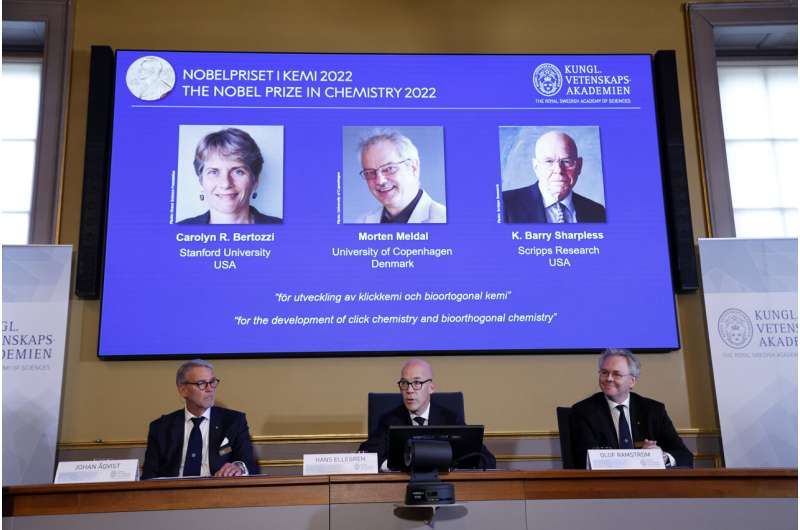
Three scientists were jointly awarded this year's Nobel Prize in chemistry on Wednesday for developing a way of "snapping molecules together" that can be used to explore cells, map DNA and design drugs that can target diseases such as cancer more precisely.
Americans Carolyn R. Bertozzi and K. Barry Sharpless, and Danish scientist Morten Meldal were cited for their work on click chemistry that works "sort of like molecular Lego."
"It's all about snapping molecules together," said Johan Aqvist, a member of the Royal Swedish Academy of Sciences that announced the winners at the Karolinska Institute in Stockholm.
Sharpless, 81, who previously won a Nobel in 2001 and is now the fifth person to receive the prize twice, first proposed the idea of connecting molecules using chemical "buckles" around the turn of the millennium, Aqvist said.
"The problem was to find good chemical buckles," he said. "They have to react with each other easily and specifically."
Meldal, 68, based at the University of Copenhagen, and Sharpless, who is affiliated with Scripps Research in California, independently found the first such candidates that would easily snap together with each other but not with other molecules, leading to applications in the manufacture of medicines and polymers.
Bertozzi, 55, who is based at Stanford University "took click chemistry to a new level," the Nobel panel said, by finding a way to make the process work inside living organisms without disrupting them.
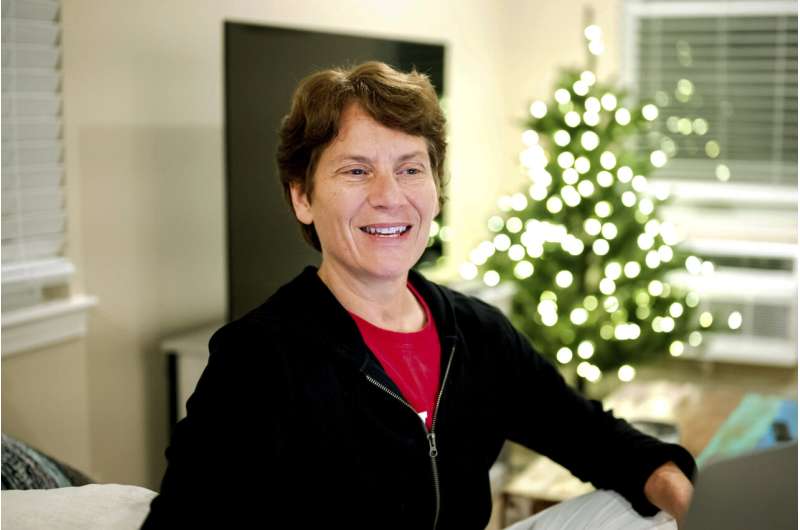
The goal is "doing chemistry inside human patients to make sure that drugs go to the right place and stay away from the wrong place," she said at a news conference following the announcement.
The award was a shock, she said. "I'm still not entirely positive that it's real, but it's getting realer by the minute."
Later, speaking to The Associated Press by Zoom, Bertozzi said one of the first people she called after being awakened by the call around 2 a.m. was her father, William Bertozzi, a retired physicist and night owl, who was still awake watching TV.
"Dad, turn down the TV, I have something to tell you," she said she told him. After she assured him nothing was wrong, he guessed the news. "You won it, didn't you?"
One of three daughters, Bertozzi said she was "fortunate because I grew up with parents that were very supportive, evangelical almost, about having their girls participate in the sciences."
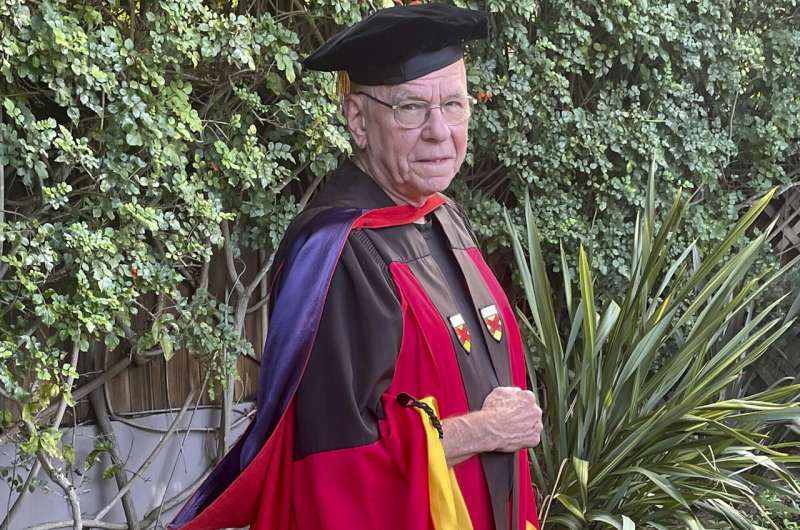
Bertozzi, who is paid by the Howard Hughes Medical Institute, which also supports The Associated Press' Health and Science Department, said she was grateful for the energy and enthusiasm that a Nobel Prize win will inject into the field.
Meldal said he received the call from the Nobel panel about half an hour before the public announcement. "They ... told me not to tell anyone," he told the AP, adding that he just sat in his office, shaking a bit.
Meldal started out as an engineer, "but I wanted to understand the world so I thought chemistry would give me the solutions."
Jon Lorsch, director of the U.S. National Institute of General Medical Sciences, which supports the work of Bertozzi and Sharpless, described click chemistry as "sort of like molecular Lego—you have a group on one molecule that specifically attaches to a group on another molecule," like Lego clicking together.
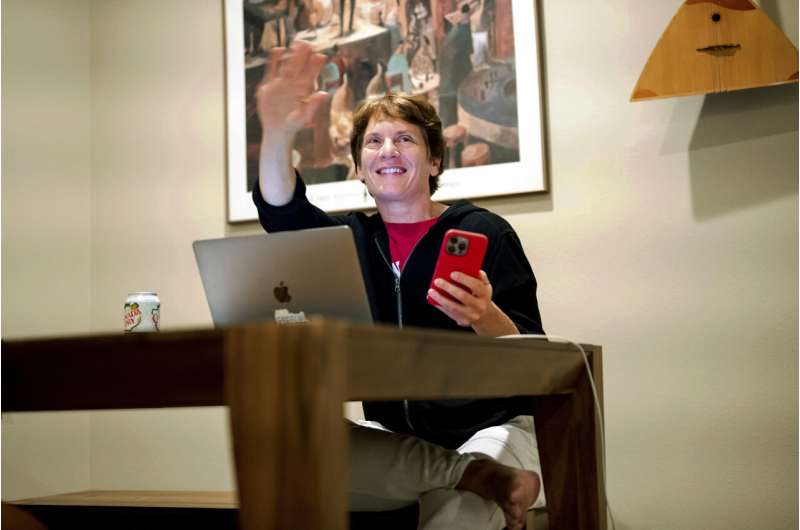
"That makes it possible to attach molecules in very specific pre-defined ways," he said, and gives scientists a very precise tool to build complex new molecules for use in drugs, synthetic materials and other uses.
However, the first iteration of click chemistry could not be used with living cells. "The original click chemistry used copper as a catalyst to join molecules," Lorsch said. "But the trouble is that copper is toxic to most living systems at higher concentrations."
Bertozzi then devised a way to jumpstart the reactions without copper or other toxic solvents—broadening the applications to human and animal tissues.
"Being able to work without dangerous solvents, opened many new doors—it enabled scientists to work on new types of reactions that actually take place within the human body," said Angela Wilson, president of the American Chemical Society.
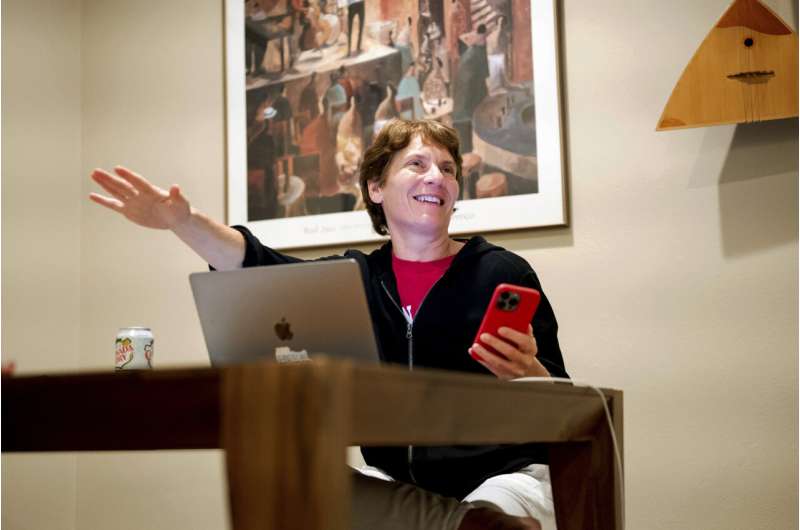
That has allowed scientists to attach dyes to cancer cells to track their movements and analyze how they differ from healthy tissue.
Wilson believes the advances of this year's Nobel laureates "will allow more individualized medicine in the future because we can really track things much better within the human body."
Sharpless credited his passion for looking for the impossible and not accepting limits for helping him stumble upon his discoveries.
"I'm just really lucky to have a photographic memory and love the periodic table," he told a virtual news conference from his home in the San Diego suburb of La Jolla. "Prizes aren't what I'm doing science for. ... I have to do it. It's kind of a compulsion,"
M.G. Finn, a chemist now at Georgia Tech who collaborated with Sharpless on his Nobel-winning work, said click chemistry's use in biology and drug development was still "at its infancy," with more exciting discoveries to come.
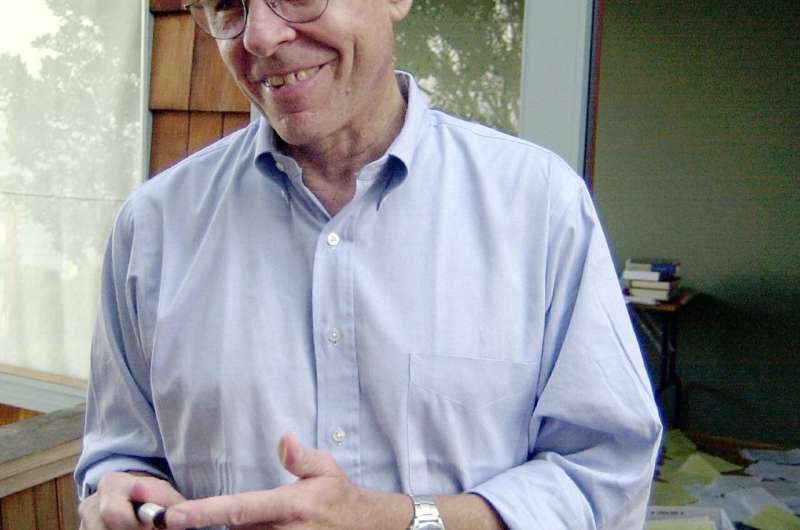
Meldal agreed.
It's "very much an opportunity ... when you get this kind of award to argue for our young people to take chemistry as a discipline," he said at a news conference in Copenhagen. "Chemistry is the solution to many of our challenges."
Last year's prize was awarded to scientists Benjamin List and David W.C. MacMillan for finding an environmentally cleaner way to build molecules that the Nobel panel said is "already benefiting humankind greatly."
A week of Nobel Prize announcements kicked off Monday with Swedish scientist Svante Paabo receiving the award in medicine for unlocking secrets of Neanderthal DNA that provided key insights into our immune system.
Three scientists won the prize in physics Tuesday. Frenchman Alain Aspect, American John F. Clauser and Austrian Anton Zeilinger showed that tiny particles can retain a connection with each other even when separated, a phenomenon that can be used for specialized computing and to encrypt information.
-
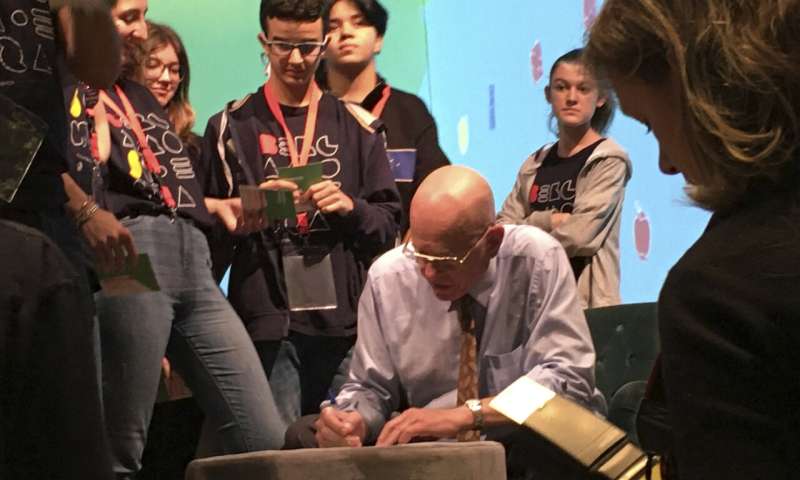
This undated photo provided by Georgia Institute of Technology shows K. Barry Sharpless, center. Three scientists were jointly awarded this year's Nobel Prize in chemistry on Wednesday, Oct. 5, 2022 for developing a way of “snapping molecules together” that can be used to design better medicines, including ones that target diseases such as cancer more precisely. Americans Sharpless and Carolyn R. Bertozzi and Danish scientist Morten Meldal were cited for their work on click chemistry and bioorthogonal reactions, which are used to make cancer drugs, map DNA and create materials that are tailored to a specific purpose. Credit: Georgia Institute of Technology via AP -
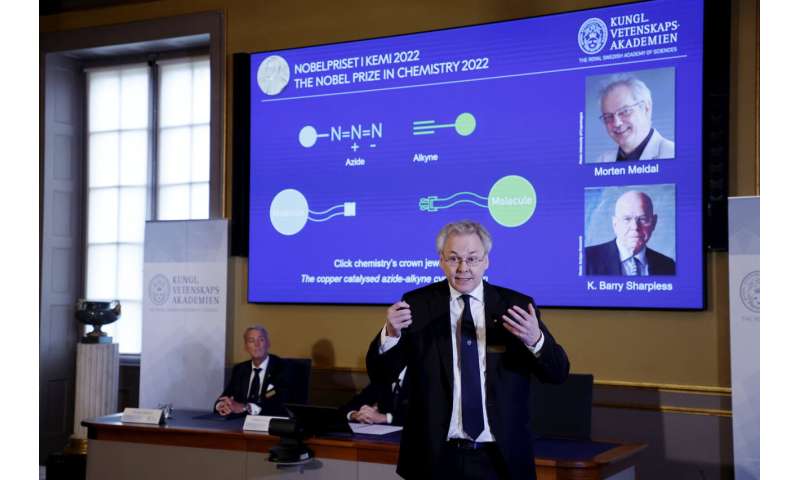
Professor Olof Ramstrom, member of the Nobel Committee for Chemistry, speaks during the press conference to announce the winners of the 2022 Nobel Prize in Chemistry, at the Royal Swedish Academy of Sciences in Stockholm, Sweden, Wednesday, Oct. 5, 2022. The winners of the 2022 Nobel Prize in chemistry are Caroline R. Bertozzi of the United States, Morten Meldal of Denmark and K. Barry Sharpless of the United States. Credit: Christine Olsson /TT News Agency via AP -
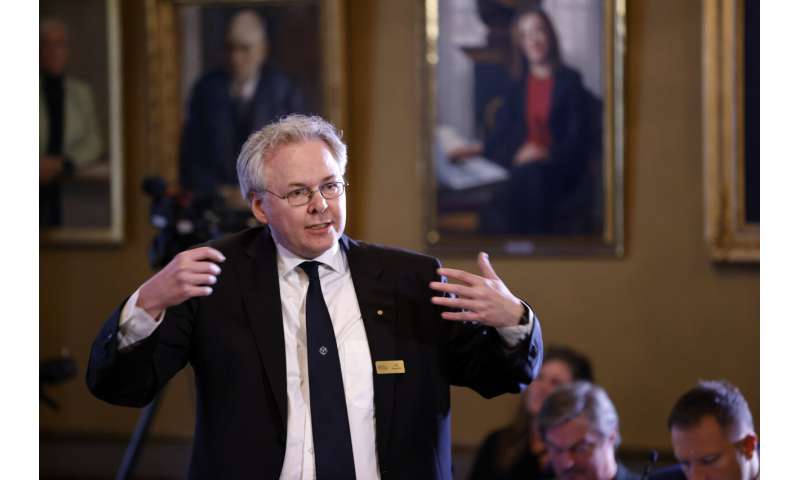
Professor Olof Ramstrom, member of the Nobel Committee for Chemistry, speaks during the press conference to announce the winners of the 2022 Nobel Prize in Chemistry, at the Royal Swedish Academy of Sciences in Stockholm, Sweden, Wednesday, Oct. 5, 2022. The winners of the 2022 Nobel Prize in chemistry are Caroline R. Bertozzi of the United States, Morten Meldal of Denmark and K. Barry Sharpless of the United States. Credit: Christine Olsson /TT News Agency via AP -
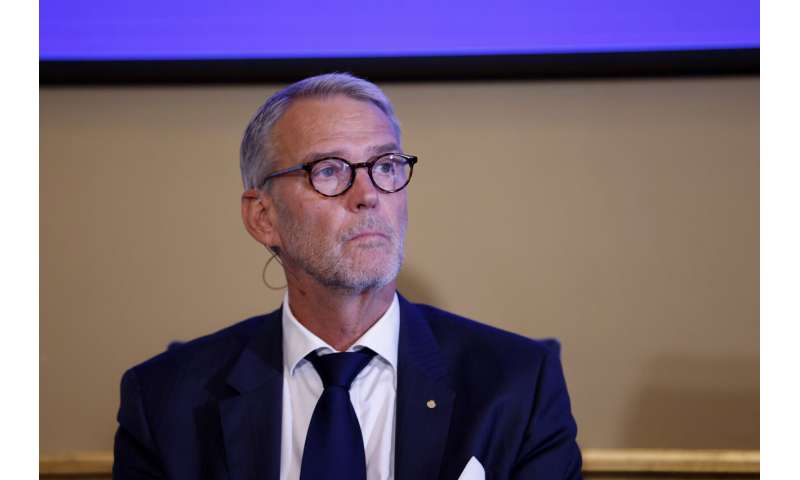
Jonas Aqvist, Chairman of the Nobel Committee for Chemistry, looks on during the press conference to announce the winners of the 2022 Nobel Prize in Chemistry, at the Royal Swedish Academy of Sciences in Stockholm, Sweden, Wednesday, Oct. 5, 2022. The winners of the 2022 Nobel Prize in chemistry are Caroline R. Bertozzi of the United States, Morten Meldal of Denmark and K. Barry Sharpless of the United States. Credit: Christine Olsson /TT News Agency via AP
The awards continue with literature on Thursday. The 2022 Nobel Peace Prize will be announced Friday and the economics award on Monday.
The prizes carry a cash award of 10 million Swedish kronor (nearly $900,000) and will be handed out on Dec. 10. The money comes from a bequest left by the prize's creator, Swedish inventor Alfred Nobel, in 1895.
Nobel Committee press release:
The Royal Swedish Academy of Sciences has decided to award the Nobel Prize in Chemistry 2022 to
Carolyn R. Bertozzi
Stanford University, CA, U.S.
Morten Meldal
University of Copenhagen, Denmark
K. Barry Sharpless
Scripps Research, La Jolla, CA, U.S.
"for the development of click chemistry and bioorthogonal chemistry"
It just says click—and the molecules are coupled together
The Nobel Prize in Chemistry 2022 is about making difficult processes easier. Barry Sharpless and Morten Meldal have laid the foundation for a functional form of chemistry—click chemistry—in which molecular building blocks snap together quickly and efficiently. Carolyn Bertozzi has taken click chemistry to a new dimension and started utilising it in living organisms.
Chemists have long been driven by the desire to build increasingly complicated molecules. In pharmaceutical research, this has often involved artificially recreating natural molecules with medicinal properties. This has led to many admirable molecular constructions, but these are generally time consuming and very expensive to produce.
"This year's Prize in Chemistry deals with not overcomplicating matters, instead working with what is easy and simple. Functional molecules can be built even by taking a straightforward route," says Johan Åqvist, Chair of the Nobel Committee for Chemistry.
Barry Sharpless—who is now being awarded his second Nobel Prize in Chemistry—started the ball rolling. Around the year 2000, he coined the concept of click chemistry, which is a form of simple and reliable chemistry, where reactions occur quickly and unwanted by-products are avoided.
Shortly afterwards, Morten Meldal and Barry Sharpless—independently of each other—presented what is now the crown jewel of click chemistry: the copper catalysed azide-alkyne cycloaddition. This is an elegant and efficient chemical reaction that is now in widespread use. Among many other uses, it is utilised in the development of pharmaceuticals, for mapping DNA and creating materials that are more fit for purpose.
Carolyn Bertozzi took click chemistry to a new level. To map important but elusive biomolecules on the surface of cells—glycans—she developed click reactions that work inside living organisms. Her bioorthogonal reactions take place without disrupting the normal chemistry of the cell.
These reactions are now used globally to explore cells and track biological processes. Using bioorthogonal reactions, researchers have improved the targeting of cancer pharmaceuticals, which are now being tested in clinical trials.
Click chemistry and bioorthogonal reactions have taken chemistry into the era of functionalism. This is bringing the greatest benefit to humankind.
Their functional chemistry works wonders
Sometimes simple answers are the best. Barry Sharpless and Morten Meldal are awarded the Nobel Prize in Chemistry 2022 because they brought chemistry into the era of functionalism and laid the foundations of click chemistry. They share the prize with Carolyn Bertozzi, who took click chemistry to a new dimension and began using it to map cells. Her bioorthogonal reactions are now contributing to more targeted cancer treatments, among many other applications.
Ever since the birth of modern chemistry in the eighteenth century, many chemists have used nature as their role model. Life itself is the ultimate proof of nature's supreme ability to create chemical complexity. The magnificent molecular structures found in plants, microorganisms and animals have spurred researchers to try to construct the same molecules artificially. Imitating natural molecules has often also been an important part in the development of pharmaceuticals, because many of them have been inspired by natural substances.
Centuries of accumulated knowledge in chemistry has proved its worth. Using the sophisticated tools they have developed, chemists can now create the most astounding molecules in their laboratories. However, one challenging problem is that complex molecules must be built in many steps, with each step creating unwanted by-products—sometimes more and sometimes fewer. These by-products must be removed before the process can continue and, for demanding constructions, the loss of material can be so great that hardly anything is left. Chemists often achieve their challenging aims, but the route there can be both time consuming and expensive. The Nobel Prize in Chemistry 2022 is about finding new chemical ideals and letting simplicity and functionality take precedence.
Chemistry has entered the era of functionalism
Barry Sharpless, who is now being awarded his second Nobel Prize in Chemistry, was the one who started the snowball rolling. Around the turn of the century, he coined the concept of click chemistry for a functional form of chemistry, where molecular building blocks snap together quickly and efficiently. The snowball became an avalanche when Morten Meldal and Barry Sharpless—independently of each other—discovered what has become the crown jewel of click chemistry: the copper catalysed azide-alkyne cycloaddition.
Carolyn Bertozzi developed click reactions that can be used inside living organisms. Her bioorthogonal reactions—which occur without disturbing the normal chemistry of the cell—are used globally to map how cells function. Some researchers are now investigating how these reactions can be used to diagnose and treat cancer, something we will return to. Let us now follow the first of the two threads that lead to the Nobel Prize in Chemistry 2022.
Sharpless believes chemists need new ideals
We start unravelling this thread in 2001, the same year that Barry Sharpless received his first Nobel Prize in Chemistry. However, that was yet to happen when he, in a scientific journal, argued for a new and minimalistic approach in chemistry. He believed it was time for chemists to stop imitating natural molecules. This often resulted in molecular constructions that were very difficult to master, which is an obstacle to the development of new pharmaceuticals.
If a potential pharmaceutical is found in nature, small volumes of the substance can often be manufactured for in vitro testing and clinical trials. However, if industrial production is required at a later stage, a much higher level of production efficiency is necessary. Sharpless used a powerful antibiotic, meropenem, as an example. Six years of chemical development work were necessary to find a way of producing the molecule on a large scale.
Wrangling molecules is expensive
One stumbling block for chemists, according to Barry Sharpless, was the bonds between carbon atoms that are so vital to the chemistry of life. In principle, all biomolecules have a framework of linked carbon atoms. Life has evolved methods for creating these, but it has proven notoriously difficult for chemists. The reason is that carbon atoms from different molecules often lack a chemical drive to form bonds with each other, so they need to be artificially activated. This activation often leads to numerous unwanted side reactions and a costly loss of material.
Instead of trying to wrangle reluctant carbon atoms into reacting with each other, Barry Sharpless encouraged his colleagues to start with smaller molecules that already had a complete carbon frame. These simple molecules could then be linked together using bridges of nitrogen atoms or oxygen atoms, which are easier to control. If chemists choose simple reactions—where there is a strong intrinsic drive for the molecules to bond together—they avoid many of the side reactions, with a minimal loss of material.
Click chemistry—functional green chemistry with huge potential
Barry Sharpless called this robust method for building molecules click chemistry, saying that even if click chemistry cannot provide exact copies of natural molecules, it will be possible to find molecules that fulfil the same functions. Combining simple chemical building blocks makes it possible to create an almost endless variety of molecules, so he was convinced that click chemistry could generate pharmaceuticals that were as fit for purpose as those found in nature, and which could be produced on an industrial scale.
In his publication from 2001, Sharpless listed several criteria that should be fulfilled for a chemical reaction to be called click chemistry. One of these is that the reaction should be able to occur in the presence of oxygen and in water, which is a cheap and environmentally friendly solvent.
He also provided examples of several existing reactions that he believed fulfilled the new ideals he had laid out. However, no one yet knew of the brilliant reaction that has now become almost synonymous with click chemistry—the copper catalysed azide-alkyne cycloaddition. This was about to be discovered in a laboratory in Denmark.
The click reaction that changed chemistry
Azides and alkynes react very efficiently when copper ions are added. This reaction is now used globally to link molecules together in a simple manner.
An unexpected substance in Meldal's reaction vessel
A great deal of decisive scientific progress occurs when researchers least expect it, and this was the case for Morten Meldal. In the early years of this century, he was developing methods for finding potential pharmaceutical substances. He constructed enormous molecular libraries, which could include hundreds of thousands of different substances, and then screened them all to see whether any of them could block pathogenic processes.
While doing this, one day he and his colleagues conducted a purely routine reaction. You don't need to remember this bit, but their aim was to react an alkyne with an acyl halide. The reaction usually goes smoothly, as long as chemists add some copper ions and perhaps a pinch of palladium as catalysts. But when Meldal analysed what happened in the reaction vessel he found something unexpected. It turned out that the alkyne had reacted with the wrong end of the acyl halide molecule. At the opposite end was a chemical group called an azide (illustrated above). Together with the alkyne, the azide created a ring-shaped structure, a triazole.
This reaction was something special
People who understand some chemistry may know that triazoles are useful chemical structures; they are stable and are found in some pharmaceuticals, dyes and agricultural chemicals, among other things. Because triazoles are desirable chemical building blocks, researchers had previously tried to create them from alkynes and azides, but this led to unwanted by-products. Morten Meldal realised that the copper ions had controlled the reaction so that, in principle, only one substance formed. Even the acyl halide—which really should have bonded to the alkyne—remained more or less untouched in the vessel. It was therefore obvious to Meldal that the reaction between the azide and alkyne was something exceptional.
He first presented his discovery at a symposium in San Diego, in June 2001. The following year, 2002, he published an article in a scientific journal, showing that the reaction can be used to bond together numerous different molecules.
Molecules snap together quickly and efficiently
That same year—independently of Morten Meldal—Barry Sharpless also published a paper about the copper catalysed reaction between azides and alkynes, showing that the reaction works in water and is reliable. He described it as an "ideal" click reaction. The azide is like a loaded spring, where the force is released by the copper ion. The process is robust and Sharpless proposed that chemists can use the reaction to easily link different molecules. He described its potential as enormous. In retrospect, we can see that he was right. If chemists want to link two different molecules they can now, relatively easily, introduce an azide in one molecule and an alkyne in the other. They then snap the molecules together with the help of some copper ions.
Click reactions can be used to create new materials
This simplicity has led to the reaction becoming tremendously popular, both at research laboratories and in industrial development. Among other things, click reactions facilitate the production of new materials that are fit for purpose. If a manufacturer adds a clickable azide to a plastic or fibre, changing the material at a later stage is straightforward; it is possible to click in substances that conduct electricity, capture sunlight, are antibacterial, protect from ultraviolet radiation or have other desirable properties. Softeners can also be clicked into plastics, so they do not leak out later. In pharmaceutical research, click chemistry is used to produce and optimise substances that can potentially become pharmaceuticals.
There are many examples of what click chemistry can achieve. However, something that Barry Sharpless did not predict was that it would be used in living beings. Now we will unravel the second thread in the Nobel Prize in Chemistry 2022.
Bertozzi starts investigating elusive carbohydrates
This thread begins in the 1990s, when biochemistry and molecular biology were undergoing explosive progress. Using new methods in molecular biology, researchers around the world were mapping genes and proteins in their attempts to understand how cells work. There was a pioneering spirit and, every day, new knowledge was generated about areas that had once been terra incognita.
However, one group of molecules received hardly any attention: glycans. These are complex carbohydrates that are built from various types of sugar and often sit on the surface of proteins and cells. They play an important role in many biological processes, such as when viruses infect cells or when the immune system is activated. Glycans are therefore interesting molecules, but the problem was that the new tools for molecular biology could not be used to study them. Anyone who wanted to understand how glycans work therefore faced an enormous challenge. Only a few researchers were prepared to try to climb that mountain—and one of them was Carolyn Bertozzi.
Bertozzi has a bright idea…
In the early 1990s, Carolyn Bertozzi began mapping a glycan that attracts immune cells to lymph nodes. The lack of efficient tools meant that it took four years to get a grip on how the glycan functioned. This challenging process made her dream of something better—and she had an idea. During a seminar, she listened to a German scientist who explained how he had succeeded in getting cells to produce an unnatural variant of sialic acid, one of the sugars that build up glycans. Bertozzi therefore started to wonder whether she could use a similar method to get cells to produce a sialic acid with a type of chemical handle. If the cells could incorporate the modified sialic acid in different glycans, she would be able to use the chemical handle to map them. She could, for example, attach a fluorescent molecule to the handle. The emitted light would then reveal where the glycans were hidden in the cell.
This was the start of long and focused development work. Bertozzi started searching through the scientific literature for chemical handles and a chemical reaction she could use. This was no easy task, because the handle must not react with any other substance in the cell. It had to be insensitive to absolutely everything apart from the molecules she was going to link to the handle. She established a term for this: the reaction between the handle and the fluorescent molecule had to be bioorthogonal.
…and make the hidden glycans reveal themselves
To make a long story short, in 1997 Carolyn Bertozzi succeeded in proving that her idea really worked. The next breakthrough occurred in 2000, when she found the optimal chemical handle: an azide. She modified a known reaction—the Staudinger reaction—in an ingenious manner, and used it to connect a fluorescent molecule to the azide she introduced to the cells' glycans. Because the azide does not affect the cells, it can even be introduced into living creatures.
With this, she had already given an important gift to biochemistry. With a little chemical creativity, her modified Staudinger reaction can be used to map cells in a variety of ways, but Bertozzi was still not satisfied. She had realised that the chemical handle she used—the azide—had a lot more to give.
Blows new life in an old reaction
At this time, word was spreading among chemists about Morten Meldal's and Barry Sharpless' new click chemistry, so Carolyn Bertozzi was well aware that her handle—the azide—can rapidly click onto an alkyne as long as there are available copper ions. The problem is that copper is toxic to living things. So she once again began to dig deep into the literature, and found that back in 1961 it had been shown that azides and alkynes can react in an almost explosive manner—without the help of copper—if the alkyne is forced into a ring-shaped chemical structure. The strain creates so much energy that the reaction runs smoothly.
The reaction worked well when she tested it in cells. In 2004, she published the copper-free click reaction, called the strain-promoted alkyne-azide cycloaddition—and then demonstrated that it can be used to track glycans (see the illustration above).
Click reactions put a spotlight on the cell
This milestone was also the start of something much bigger. Carolyn Bertozzi has continued refining her click reaction, so it works even better in cell environments. In parallel with this, she and many other researchers have also used these reactions to explore how biomolecules interact in cells and to study disease processes.
One area that Bertozzi focuses on is glycans on the surface of tumour cells. Her studies have led to the insight that some glycans appear to protect tumours from the body's immune system, as they make the immune cells shut down. To block this protective mechanism, Bertozzi and her colleagues have created a new type of biological pharmaceutical. They have joined a glycan-specific antibody to enzymes that break down the glycans on the surface of the tumour cells. This pharmaceutical is now being tested in clinical trials on people with advanced cancer.
Many researchers have also started to develop clickable antibodies that target a range of tumours. Once the antibodies attach to the tumour, a second molecule that clicks to the antibody is injected. For example, this could be a radioisotope that can be used to track tumours using a PET scanner or that can aim a lethal dose of radiation at the cancer cells.
Elegant, clever and novel, but most of all useful
We do not yet know whether these new therapies will work—but one thing is clear: research has just touched on the enormous potential of click chemistry and bioorthogonal chemistry. When Barry Sharpless gave his first Nobel Lecture in Stockholm in 2001, he talked about his childhood, which was coloured by the simple values of the Quakers and has influenced his ideals. He said:
"Elegant" and "clever" were the chemical accolades of choice when I started doing research, just as "novel" is high praise now. Perhaps the Quakers are responsible for me valuing "useful" most.
All four of these words of praise are necessary to do justice to the chemistry for which he, Carolyn Bertozzi and Morten Meldal have laid the foundation. In addition to being elegant, clever, novel and useful, it also brings the greatest benefit to humankind.
More information: Scientific background: Click chemistry and bioorthogonal chemistry (pdf)
© 2022 The Associated Press. All rights reserved. This material may not be published, broadcast, rewritten or redistributed without permission.





















